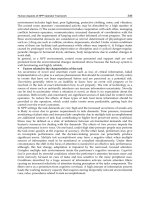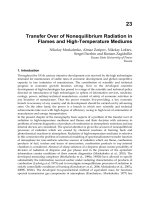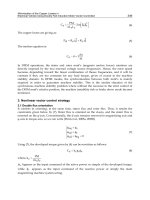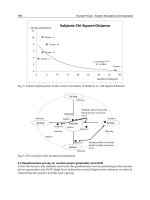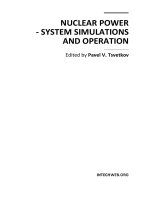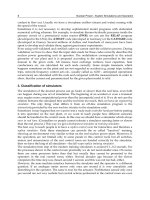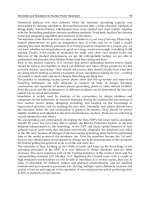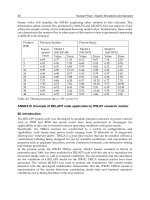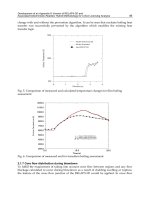Nuclear Power Operation Safety and Environment Part 13 pdf
Bạn đang xem bản rút gọn của tài liệu. Xem và tải ngay bản đầy đủ của tài liệu tại đây (2.2 MB, 20 trang )
Effects of Gamma-Ray Irradiation on Tracking Failure of Polymer Insulating Materials
349
interval, the carbonization forms more quickly and the brief short circuit occurs more
frequently, and the discharges could not completely take place, so the total discharge
quantity is smaller as shown in Fig. 7b.
The dielectric properties are improved for PBN but worsened for PBT by gamma-ray
irradiation. This difference is attributed to the radiation-induced cross-linking and
degradation. The effect of the total dose on electrical properties is markedly different,
depending on the chemical structure of the base polymer. The radiation adds a particular
dimension to the aging problem, because it interacts strongly with materials in general and
brings about structural changes that alter their properties. This is because that it can alter the
macroscopic properties of polymeric materials through mechanisms like chain scission,
cross linking and oxidation. Comparing the molecule formulas, there are two phenyls in the
main chain of PBN but one for PBT. The amount of phenyl in the main chain plays a main
role on the result of the radiation reaction. In another word, the dielectric properties of
polybutylene polymers are improved for PBN which contains more combined phenyls in
the main chain. It is known that to disrupt the two combined phenyls needs more energy
than one phenyl. It is supposed that the disruption of the bonds is harder for PBN than PBT
after the same dosage of the irradiation. The formation of new bonds does not seem to have
much difference because of the same fringe structure. The new main chain is bigger for PBN
because of more phenyls. For PBN, it is considered that the effects of the new bonds exceed
the disruptive ones. For PBT, it is considered to be opposite to PBN. Therefore, PBN
represents cross-linking type results and PBT represents scission type results.
4.2 Effects of tracking resistance by use of IEC60112 method
To estimate the resistance to tracking of polymer material, there are many traditional
methods including recording the time to dielectric breakdown, calculating the discharge
quantity, measuring the dielectric loss angle and testing the CTI value. Among the
methods, the CTI value is extremely important and also considered as an index mark to
select insulating materials. The minimal voltage, which could cause tracking failure with
the application of 50 drops of electrolyte, is used as a measure of the susceptibility of the
material to tracking and is defined as the CTI value according to IEC60112. The example
of discharge events is shown in Fig. 8. The test solution is evaporated by Joule heat caused
by leakage current which flows between the electrodes across the sample surface. A
discharge appears at the dry band. After the appearance of the discharge, the sample
surface is eventually dried between the electrodes. The initiation of a carbon deposit is
(a) Scintillation discharge (b) Arc discharge (c) Discharge and carbonization (d) Intense discharge
Fig. 8. Example of discharge events with 100 kGy irradiated M-PC.
Nuclear Power – Operation, Safety and Environment
350
closely related to the location where a dry band is formed in the evaporation of solution
due to Joule heat, and to heat degradation of the sample surface caused by scintillation
discharge across the dry band. With further application of the test solution, the erosion of
the sample surface occurs as a result of the tracking test. Fig.9 shows the relation between
dosage of the irradiation and the CTI value for both PET and PBT with ac voltage
application. As total dosage increases, the CTI value of PET increases, but the CTI of PBT
decreases.
Fig. 9. Relation between the CTI value and the dosage of gamma-ray irradiation
(a) Erosion depth (b) Weight loss
Fig. 10. The changes of tracking resistance on M-PC
Fig. 10 shows the relationship between the biggest erosion depths, weight loss and test
voltage with M-PC. For the range of irradiation, both the erosion depths and weight loss are
smaller than that of unirradiated samples. It indicated that after the irradiation, the tracking
resistance was improved. A cross-linking reaction of an organic material is one main factor
for improving tracking resistance and conversely a degradation reaction is conceivable as a
factor for decreasing tracking resistance. It is believed that the improvement is due to the
result of the cross-linking reaction. However, both the erosion depths and weight loss
decreases with increasing the total dose from 0 kGy to 100 kGy, but increases from 100 kGy
to 1000 kGy. It indicates that there is a threshold value for the tracking resistance of M-PC
Effects of Gamma-Ray Irradiation on Tracking Failure of Polymer Insulating Materials
351
around 100 kGy. When the total dose exceeds the threshold value, the tracking resistance
begins to decrease. The decrease might be attributed to the result of the degradation
reaction.
The M-PC is mixed with 3% PE. It is known that gamma-ray irradiation caused degradation
reaction with PC. Therefore, the mixing of PE maybe one main reason for the improvement
of the tracking resistance with irradiated M-PC. In order to confirm the judgment, the
tracking resistance of PE after gamma-ray irradiation was investigated.
Fig. 11 shows the relationship between the biggest erosion depths, weight loss and test
voltage with PE. For the range of the irradiation, both the erosion depths and weight loss
decreased with the increase of the total dose. Accordingly, the trend that the tracking
resistance improves through gamma-ray irradiation is assumed. It is also supposed that the
heat from irradiation causes the formation of 3-dimensional structures, which strengthens
the PE by cross-linking reaction. Therefore, the mixing of PE is probably one main reason for
the improvement of the tracking resistance with irradiated M-PC.
(a) Erosion depth (b) Weight loss
Fig. 11. The changes of tracking resistance on PE
5. Effect of gamma-ray irradiation on tracking resistance under reduced
pressure
The relation between the time to tracking failure and the total dose of the irradiation under
100 kPa and 1 kPa are shown in Figs. 12, 13 and 14. With increasing the total dose of
irradiation, the time to tracking failure increases with PBN and PET, but decreases with PBT
for the investigated range of the irradiation. With the decrease of the atmospheric pressure,
the time to tracking failure of all samples increases. With decreasing the pulse interval, the
time to tracking failure of all samples decreases.
With the increase of the total dose, the time to tracking failure of PBN and PET increase,
which indicates the thermal properties of tracking resistance are improved. However, the
time to tracking failure of PBT decreases with the increase of the total dose, which
indicates that the thermal properties of tracking resistance are worsened. Evidently, the
total dose has different effects on the polymers. A cross-linking reaction is one main factor
for improving tracking resistance and conversely a degradation reaction is conceivable as
a factor for decreasing tracking resistance. The atoms that make up a polymer are
Nuclear Power – Operation, Safety and Environment
352
bounded together by weak covalent bonds that are disrupted easily by gamma-ray
radiation, and as bonds are broken, new ones are formed and the structure of the polymer
is altered. In practice, cross-linking and degradation reaction often occur simultaneously,
and the reaction result is determined by the one that is dominant. For PBN and PET, it is
supposed that the cross- linking reaction is superior to the degradation reaction and the
combination between the molecules extends the three-dimensional networks. For PBT, it
is supposed that the degradation reaction is superior to the cross-linking reaction and the
scission of the main chain bonds results in the formation of low-molecular-weight chain
fragments.
The time to tracking failure of all samples increases with the decrease of the atmospheric
pressure. Under the reduced pressure, the supply of oxygen is not sufficient. The probability
of the oxidation reaction on sample surface and the cracked gas decreases with the decrease
of the oxygen content. The burning becomes more difficult and the complete carbonized
conductive path becomes hard to form. Therefore, the time to tracking failure increases with
the decrease of the atmospheric pressure.
(a) Pulse interval with 7 ms (b) Pulse interval with 5 ms
Fig. 12. Relation between the time to tracking failure and the total dose of irradiation for
PBN
(a) Pulse interval with 7 ms (b) Pulse interval with 5 ms
Fig. 13. Relation between the time to tracking failure and the total dose of irradiation for PET
Effects of Gamma-Ray Irradiation on Tracking Failure of Polymer Insulating Materials
353
(a) Pulse interval with 7 ms (b) Pulse interval with 5 ms
Fig. 14. Relation between the time to tracking failure and the total dose of irradiation for PBT
The time to tracking failure of all samples decreases with the decrease of the pulse interval.
When the pulse interval decreases, electron emission from the electrode becomes more
frequent, the heat caused by the discharge energy makes the carbon chain of the molecules
broken increases, and the carbon conductive path of polymer surface forms more steadily.
As a result, the time to tracking failure decreases. In addition, at the pulse interval of 10 ms,
the accurate time to tracking failure is not shown from Figs. 12 to 14 as the tracking failure
does not occur until 300 s under the same condition as pulse intervals of 7 ms and 5 ms.
The discharge quantity is a token of the heat-durability. The tracking failure mainly depends
upon the heat energy formed by the discharge. If discharge quantity is smaller, it suggests
that the carbon chain is more difficult to be broken. The relationship between the discharge
quantity and the total dose of irradiation before tracking failure for 600 discharges under
100 kPa and 1 kPa are shown in Figs 15, 16 and 17. The discharge quantity decreases with
PBN and PET, but increases with PBT with increasing the total dose of irradiation. From
Figs. 15 to 17, with the decrease of the atmospheric pressure, the discharge quantity of PBN
and PET increase, but decrease with PBT.
(a) Pulse interval with 10 ms (b) Pulse interval with 5 ms
Fig. 15. Relation between the discharge quantity and the total dose of irradiation for PBN.
The discharge quantity of PBN and PET decrease with the increase of the total dose, which
suggests that the thermal properties of tracking resistance are improved and the tracking
Nuclear Power – Operation, Safety and Environment
354
failure becomes more difficult. This fact is due to the occurrence of the cross-linking
reaction. With the increase of the total dose of irradiation, the discharge quantity increase
with PBT, which suggests that the thermal properties are worsened and the tracking failure
becomes easier. The reason for this is due to the degradation reaction by irradiation.
(a) Pulse interval with 10 ms (b) Pulse interval with 5 ms
Fig. 16. Relation between the discharge quantity and the total dose of irradiation for PET
The discharge quantity of PBN and PET increase with decreasing the atmospheric pressure.
Under the reduced atmospheric pressure, the density of the gases is decreased, the speed of
electron becomes fast, and the surface more readily causes the discharging. As a result, the
discharge quantity increases with the decrease of the atmospheric pressure. The discharge
quantity decreases with decreasing the atmospheric pressure for PBT. It is because under the
reduced atmospheric pressure, the probability of the oxidation reaction of PBT surface and
the cracked gas decrease with the decrease in the oxygen content. The carbon deposition of
PBT by the ignition to the surface increases, and the discharges can not completely take
place due to the decomposed carbon, so the total discharge quantity of PBT under the
reduced atmospheric pressure is smaller.
(a) Pulse interval with 10 ms (b) Pulse interval with 5 ms
Fig. 17. Relation between the discharge quantity and the total dose of irradiation for PBT
From Figs. 15 to 17, discharge quantity of PBN and PET increased with the decreasing the
pulse interval, but the tendency is opposite for PBT. The discharge quantity is bigger in
Effects of Gamma-Ray Irradiation on Tracking Failure of Polymer Insulating Materials
355
shorter pulse interval because the higher accumulative heat quantity of consecutive
discharge is, the more quickly tracking failure occurred. For PBN and PET, tracking failure
is more difficult due to the inherent carbonization property and the discharge is continuous.
The formation of carbon conductive path is gradual, and the discharge quantity is bigger at
the shorter pulse interval. For PBT, the formation of carbonization and tracking failure are
easier. It is observed that short-circuit forms in a very short time, and the discharge is
discontinuous. At the shorter pulse interval, the carbonization forms more quickly and the
brief short-circuit occurs more frequently, which causes the discharges cannot completely
take place, so the total discharge quantity is smaller.
The photographs of sample surface after the discharge for 20 s with the pulse interval of
10 ms under 100 kPa and 1 kPa are shown Tables 1, 2 and 3. The color of sample surfaces
is gradually dark according to the total dose of gamma-ray irradiation. The noticeable
changes of sample surface in the tracking failure process are observed. The repetitive
discharge occurs before tracking failure and the quantity of decomposition carbon
increases in the area close to the electrodes. The features of tracking failure phenomenon
are different between PBN, PET and PBT. The carbonized area decreases with PBN and
PET, but increases with PBT with increasing the total dose of irradiation. The difference
indicates that the thermal properties of tracking resistance are improved with PBN and
PET, but worsened with PBT.
Total dose 100 kPa 1 kPa
0 kGy
100 kGy
1000 kGy
Table 1. Sample surface after the carbonization with PBN
By comparison with the case of 1 kPa, the features of tracking failure phenomenon are
different in the case of 100 kPa. The oxidation reaction, which took place on the electrodes, is
an exothermic reaction initiated by scintillation discharge and increases the intensity of the
discharge. In the case of 100 kPa, there is enough aerial oxygen for the samples to be
oxidized completely, which shows more carbonization area in the second columns of Tables
1, 2 and 3. In the case of 1 kPa, there is not enough aerial oxygen for the samples to be
Nuclear Power – Operation, Safety and Environment
356
oxidized completely and the oxidation product is largely decreased, which shows less
carbonization points in the third columns of Tables 1, 2 and 3. The differences of shape and
area of carbonized resultants are independent of the carbonization process with reducing
the atmospheric pressure.
Total dose 100 kPa 1 kPa
0 kGy
100 kGy
1000 kGy
Table 2. Sample surface after the carbonization with PET
Total dose 100 kPa 1 kPa
0 kGy
100 kGy
1000 kGy
Table 3. Sample surface after the carbonization with PBT
The tracking failure properties are improved for PBN and PET but worsened for PBT by
gamma-ray irradiation. This difference is attributed to the radiation-induced cross-linking
Effects of Gamma-Ray Irradiation on Tracking Failure of Polymer Insulating Materials
357
and degradation. The effect of the total dose on electrical properties is markedly different,
depending on the chemical structure of the base polymer. The radiation adds a particular
dimension to the aging problem, because it interacts strongly with materials in general and
brings about structural changes that alter their properties. This is because that it can alter the
macroscopic properties of polymeric materials through mechanisms like chain scission,
cross-linking and oxidation. By the comparison of the molecule formulas of PBN and PBT,
there are two phenyls in the main chain of PBN but one for PBT. The amount of phenyl in
the main chain plays a main role in the result of the radiation reaction. In another word, the
resistance to the tracking failure of polybutylene polymers is improved for PBN which
contains more combined phenyls in the main chain. Comparing the molecular structures of
PET and PBT, there are four methylene groups in the chain of PBT but two for PET. The four
methylenes increase the length of the thinner, less bulky, portion of the molecular chain,
resulting in easier bending.
6. Effects of gamma-ray irradiation on tracking failure under magnetic filed
Figs. 18, 19 and 20 show the relation between the time to tracking failure and the total dose
of irradiation with and without magnetic field. The time to tracking failure increases with
increasing the total dose with PBN and PET, but decreases with PBT. Under the magnetic
field, the time to tracking failure of all the samples increases with the relative angles of 0 and
90 degrees, but decreases with the relative angle of 270 degrees.
(a) Pulse interval with 10 ms (b) Pulse interval with 5 ms
Fig. 18. Relation between the time to tracking failure and the irradiation with PBN
With increasing the total dose, the time to tracking failure of PBN and PET increases, which
indicates the properties of tracking resistance are improved. However, the time to tracking
failure of PBT decreases with increasing the total dose, which indicates that the properties of
tracking resistance are worsened.
Under the magnetic field, the time to tracking failure of the three samples are delayed with the
relative angles of 0 and 90 degrees, but shortened with the relative angle of 270 degrees. The
tracking failure is caused by the decomposed carbon on the sample surface, which is
precipitated due to heat generated by the discharge between the electrodes. Free electrons
which are emitted from electrode dissociate polymer molecules by the rupture of C-H bond.
When magnetic field is applied, an electromagnetic force, the direction of which is decided by
the direction of E×B, will affect the frequency of electron collision and the formation of
Nuclear Power – Operation, Safety and Environment
358
decomposed carbon. As a result, the dielectric performance is changed by the magnetic field.
With the relative angles of 0 and 90 degrees, the charge carriers are deflected to one side and
upward away from the surface, respectively. As a result, there is a decrease in collision
frequency and the time to tracking failure increases. When the relative angle is 270 degrees, the
electrons are deflected towards the sample surface because of the electromagnetic force. The C-
H bonds are ruptured and the carbon is separated more readily. Therefore, the time to tracking
failure is shortened with the relative angle of 270 degrees.
(a) Pulse interval with 10 ms (b) Pulse interval with 5 ms
Fig. 19. Relation between the time to tracking failure and the irradiation with PBT
(a)Pulse interval with 10 ms (b) Pulse interval with 5 ms
Fig. 20. Relation between the time to tracking failure and the irradiation with PET
Figs. 21, 22 and 23 show the relation between the discharge quantity and the total dose of
irradiation. With the increase of the total dose of irradiation, the discharge quantity
decreases with PBN and PET, but increases with PBT. Under magnetic field, the discharge
quantity of the samples increases with the relative angles of 90 and 270 degrees, but
decreases with the relative angle of 0 degree. The discharge quantity increases with the
relative angles of 90 and 270 degrees, but decreases with the relative angle of 0 degree. In
addition, it decreases with the relative angle of 90 degrees for PBT. When the relative angle
is 0 degree, the electromagnetic force is parallel to the sample surface, which makes the
electrons deviate to the surface. The tracking failure is suppressed, since the probability of
the electron collision is decreased. Therefore, the discharge quantity is smaller.
Effects of Gamma-Ray Irradiation on Tracking Failure of Polymer Insulating Materials
359
(a) Pulse interval with 10 ms (b) Pulse interval with 5 ms
Fig. 21. Relation between the discharge quantity and the total dose of irradiation with PBN
(a) Pulse interval with 10 ms (b) Pulse interval with 5 ms
Fig. 22. Relation between the discharge quantity and the total dose of irradiation with PBT
(a) Pulse interval with 10 ms (b) Pulse interval with 5 ms
Fig. 23. Relation between the discharge quantity and the total dose of irradiation with PET
Conversely, with the relative angle of 270 degrees, the electromagnetic force is downward to
the sample surface, the electron collision is increased on the sample surface and the
discharge quantity increases. The electromagnetic force is upward to the sample surface
Nuclear Power – Operation, Safety and Environment
360
with the relative angle of 90 degrees, which makes the electrons pass the sample surface
more easily. As a result, the electromagnetic force is upward to the sample surface and the
discharge quantity is larger for PBN and PET. For PBT, the tacking failure is mostly decided
by the carbonization. The electrons upward to the sample surface inhibit the carbonization
process, and the discharge quantity decreases.
The photographs of sample surface after tracking failure with the pulse interval of 10 ms at the
relative angles of 0, 90 and 270 degrees are shown in Tables 4, 5 and 6. The color of sample
surface is gradually dark according to the total dose of gamma-ray irradiation. The repetitive
discharge occurs before tracking failure and the quantity of decomposition carbon increases in
the area close to the electrodes. As shown in the Tables, the surface is carbonized by the heat
energy from the discharge. With the high repetition rate of discharges, there is a high increase
of discharge quantity that affects the carbonization progress and the situation of carbon
deposition. When the intensive discharge lasts for a period of time, the surface is carbonized
first to the area close to the electrodes. Due to the conductive nature of carbonization products,
they act as the extension of the electrodes. After a sufficiently long time, the carbonized
conduction path is finally formed over the short-circuited path.
Dosage 0 90 270
0kGy
100kGy
1000kGy
Table 4. Sample surface after the carbonization with PBN
The features of tracking failure phenomenon are different among PBN, PET and PBT. The
carbonized area decreases with PBN and PET, but increases with PBT with increasing the
total dose of irradiation. By comparing the cases of 0, 90 and 270 degrees, the features of
tracking failure phenomenon are different. The carbonization path is downside to the
sample surface with the relative angle of 0 degree. The carbonization path of 90 degrees is
narrow and the carbonization path of 270 degrees was almost circular.
The oxidation reaction, which takes place on the electrodes, is an exothermic reaction
initiated by scintillation discharge and enhanced the intensity of the discharge. When the
relative angle is 0 degree, the electromagnetic force is parallel to the sample surface, which
makes the electrons deviate to the surface of the samples. The decomposition carbon
separates out by the energy of electrons. As a result, the carbonization path is downside to
the sample surface. When the relative angle is 90 degrees, the electromagnetic force is
Effects of Gamma-Ray Irradiation on Tracking Failure of Polymer Insulating Materials
361
upward to the sample surface. There is a decrease in collision frequency of the electrons and
the sample surface. The discharge energy is smaller and the carbonization progress is
difficult. As a result, the growth of carbonization path is inhibited. The shape is narrow and
the carbonized area decreases. When the relative angle is 270 degrees, the electromagnetic
force is downward to the sample surface. The electron collision is increased on the sample
surface and the discharge energy increases. The carbonization growth is easier and the
carbonization paths extend more easily. Accordingly, the carbonization path of 90 degrees is
almost circular and the carbonized area increases. The carbonized area of 0 degree is biggest
and that of 90 degrees is smallest for PBT and PET, but that of 270 degrees is biggest for
PBN. For PBN, the development of carbonization is not complete.
Dosage 0 90 270
0kGy
100kGy
1000kGy
Table 5. Sample surface after the carbonization with PBT
Dosage 0 90 270
0kGy
100kGy
1000kGy
Table 6. Sample surface after the carbonization with PET
Nuclear Power – Operation, Safety and Environment
362
7. Recurrence plots of discharge current in tracking test
Fig. 24 shows the variation of RP topological structure at different states of discharge
process for PBT with 100 kGy dosage at 350 V. Fig. 24a shows the initial state of the test.
The sparse recurrence point density indicates a low correlation between embedding
vectors X(i) and X(j) in m-dimension space. It also shows that the beginning of the
tracking test is an unstable state due to incomplete evolution of the solution on the sample
surface, which results in leakage currents and the occurrence of discharge between tiny
droplets. Fig. 24b shows the middle state of discharge process. It shows a stationary state
which is manifested in a comparatively regular and dense recurrence point distribution.
This indicates that some embedding vectors are the same or very similar to other
embedding vectors in m-dimension phase space. It can also be considered to correspond
to the state of the discharge process when the discharge mainly occurs between the
deposited carbon patches and the process is in a comparatively stationary state. Fig. 24c
shows the state of the discharge process just before tracking failure. The topological
structure is completely different from that shown in Fig. 24a or Fig.24b. From vector X (0)
to X (4500), the main segments of the map indicates a stationary state with an exception of
a short unstable one that produced the white cross blank area between vector X (4500) to
X (5000). This also indicates that the discharge state will switch to the next state which
indicates the imminence of the breakdown.
(a) At the initial stage (b) In the middle stage (c) Just before tracking failure
Fig. 24. Recurrence plots for three different stages in the discharge
The variations of topological structures for PBT at 375 V and for PET at 450 V with the
increase of irradiation dosage are shown in Fig. 25. In Fig. 25a, the point density of PBT
decreases with the increase of the irradiation dosage. By contrast, in Fig. 25b, the point
density of PET increases with the increase of irradiation dosage. The two opposite
tendencies of recurrence point density indicate that gamma-ray irradiation has completely
different effects on the resistance to tracking for PBT and PET.
In order to understand the underlying mechanism of the confusing discharge process, the
RP has been made to evaluate the tracking resistance. Fig. 26 shows the RPs of the discharge
resulting from the application of 400V with M-PC. The structures of the irradiated samples
are different from that of the unirradiated ones and there are bigger white space segments in
the plot of the unirradiated sample. The white space segments stand for inflation processes
due to the high amplitude transients, which indicate that there are high amplitude changes
in the discharge currents of unirradiated sample and the fluctuation is more strenuous than
that of the total dose at 100 kGy and 1000 kGy. The discharge processes change due to the
Effects of Gamma-Ray Irradiation on Tracking Failure of Polymer Insulating Materials
363
increase of the irradiation. There is almost no obvious difference in the white space, but the
point density increases with the irradiation dosage from 100 kGy to 1000 kGy, which
indicates that the embedding vectors are very similar to the neighbor vectors. It is suggested
that the discharge process at 1000 kGy is more intensive than that at 100 kGy. This results of
is related to the phenomenon in which as total dose increases, the tracking resistance of M-
PC is improved compared with unirradiated samples and the tracking resistance decreases
with the total dose from 100 kGy to 1000 kGy.
(i) 0 kGy (ii) 100 kGy (iii) 1 MGy
(a) PBT, the applied voltage was 375 V
(i) 0 kGy (ii) 100 kGy (iii) 1 MGy
(b) PET, the applied voltage was 450 V
Fig. 25. Relation between the RP and the dosage of gamma-ray irradiation
(a) Unirradiation (b) 100 kGy (c) 1000 kGy
Fig. 26. RPs of discharge currents with M-PC
Fig. 27 shows the recurrence plots of the discharge currents with PE at 400V. The point
density and the white spaces all decrease with the increase of the irradiation dosage, which
Nuclear Power – Operation, Safety and Environment
364
indicates the intensity and the high amplitude transients of the discharge currents decrease.
These results are related to the phenomenon where as total dose increases the tracking
resistance of PE is improved. It is also confirmed that the point density and the white space
are directly related to the features of the discharge process.
Fig. 28 shows the relationship between the quantitative indicators and the gamma-ray
radiation. The RR increases for M-PC but decreases for PE with the increase of the radiation
dosage, while the DET of PE increases. The DET of M-PC increases with the total dose from
0 kGy to 100 kGy and decreases from 100 kGy to 1000 kGy. For M-PC, the increasing of RR
indicates that the intensity of the discharge currents increases. The DET increases first and
then decreases indicate that the deterministic ingredients of the discharge currents increases
first and then decreases with increasing the radiation dosage. For PE, the decreasing of RR
and the decreasing of DET indicate that the discharge is more stable and regular.
(a) Unirradiation (b) 100 kGy (c) 1000 kGy
Fig. 27. RPs of discharge currents with PE
0 500 1000
0.001
0.002
0.005
0.01
M-PC
PE
Total Dose of Irradiation
(
KG
y)
0 100 1000
R
R
0 500 1000
0.01
0.03
0.1
0.3
1
Total Dose of Irradiation
(
KG
y)
M-PC
PE
0 100 1000
DET
(a) RR (b) DET
Fig. 28. Relationship between the quantitative indicators and the gamma-ray radiation
8. Conclusions
The effects of gamma-ray irradiation on dielectric breakdown have been studied by
applying a dc pulse voltage. The experiments reveal that the dielectric properties of
polybutylene polymers are obviously changed by the gamma-ray irradiation. With the
Effects of Gamma-Ray Irradiation on Tracking Failure of Polymer Insulating Materials
365
increase of the total dose of irradiation, the time to dielectric breakdown increases with
PBN, but decreases with PBT, the discharge quantity decreases with PBN, but increases with
PBT. It indicates that the total dose of irradiation has a converse effect on the discharge
quantities. The discharge quantity increases with the decrease of the discharge interval with
PBN, but the tendency is opposite with PBT. Time to dielectric breakdown for both PBN and
PBT all decreases with the decrease of the discharge interval. The dielectric properties of
PBN are improved, but worsened for PBT by gamma-ray irradiation. Dielectric properties
are improved by irradiation for polybutylene polymers which contain more combined
phenyls in the main chain.
The tracking resistance of gamma-ray irradiated polycarbonate mixed with polyethylene by
use of IEC 60112 is studied. With the increase of the total dose of Gamma-ray irradiation,
both the erosion depth and weight loss are smaller than that of unirradiated samples, which
show the tracking resistance is improved. Both the erosion depth and weight loss decrease
with the total dose increasing from 0 kGy to 100 kGy, but increase from 100 kGy to 1000
kGy. There is a threshold value for the tracking resistance near 100 kGy. When the total dose
exceeds the threshold value, the tracking resistance begins to decrease.
The effect of gamma-ray irradiation on tracking failure of PBN, PBT and PET by applying a
dc pulse voltage under reduce atmospheric pressure is studied. With the decrease of the
atmospheric pressure, the time to tracking failure and the discharge quantity all increase
with PBN and PET. The time to tracking failure is delayed with PBT, and the discharge
quantity decreases with decreasing the atmospheric pressure. It is found that the irradiation
and reduced pressure stress response of PBN, PET and PBT are variable: the resistance to
tracking failure of PBN and PET are improved, but worsened for PBT by gamma-ray
irradiation and the resistance to tracking failure of all them are influenced obviously by the
reduced atmospheric pressure.
The effects of gamma-ray irradiation and magnetic field on tracking failure of PBN, PBT and
PET by applying a HV pulse voltage are studied. Under the magnetic field, the time to
tracking failure of all the samples are delayed with the relative angles of 0 and 90 degrees,
but decrease with the relative angle of 270 degrees, the discharge quantity of the samples
increase with the relative angles of 90 and 270 degrees, but decrease with the relative angle
of 0 degree. In addition, it decreases with the relative angle of 90 degrees for PBT. The
carbonization path is downside to the sample surface with the relative angle of 0 degree.
The carbonization path of 90 degrees is narrow and the carbonization path of 270 degrees is
almost circular. The carbonized area decreases from 0 to 90 degrees and then increases from
90 to 270 degrees for all the samples. The carbonized area of 0 degree is biggest and that of
90 degrees is smallest for PBT and PET, but that of 270 degrees is biggest for PBN.
Recurrence plots are employed to evaluate the resistance to tracking of polymer samples
with gamma-ray irradiation. The results obtained show that it is useful to visualize the state
of discharge process. The recurrence plots confirmed by the CTI can successfully indicate
the resistance to tracking of polymer material with gamma-ray irradiation. Recurrence plots
can serve as a visual method to identify different dynamic systems and reveal time-domain
features of the discharge. The recurrence point density decreases with the increase of the
dosage of irradiation for PBT. This can be explained by the resistance to tracking of PBT
decreasing by increasing the dosage of gamma-ray irradiation. On the other hand, with the
increase of the dosage of gamma-ray irradiation, the recurrence point density increases for
PET, indicating less complex discharge process. This can be explained due to cross-linking
Nuclear Power – Operation, Safety and Environment
366
being the predominant process through irradiation. The improvement in mechanical and
thermal performance through irradiation leads to less easy carbonization. In the dc tracking
test of gamma-ray irradiated polycarbonate, the topological structures of the recurrence
plots with the irradiated samples are different from that of the unirradiated sample. There
are bigger white space segments, which indicate that there are high amplitude transients in
the discharge currents of unirradiated sample. The recurrence point density increases from
100 kGy to 1000 kGy, which suggests that the discharge processes of the total dose at 1000
kGy irradiated samples is more intensive than that at 100 kGy.
9. References
N. Yoshimura, S. Kumagai & B. X. Du. Research in Japan on the Tracking Phenomenon of
Electrical Insulating Materials. IEEE Electrical Insulation Magazine, Vol.13, No.5,
(October 1997), pp.8-19, ISSN 0883-7554.
B. X. Du, Yong Liu & H. J. Liu. Effects of Low Pressure on Tracking Failure of Printed
Circuit Boards. IEEE Transactions on Dielectrics and Electrical Insulation, Vol.15, No. 5,
(October 2008), pp.1379-1384, ISSN 1070-9878.
G. C. Stone, R. G. Van Heeswijk & R. Bartnikas. Electrical Aging and Electroluminescence in
Epoxy under Repetitive Voltage Surges. IEEE Transactions on Electrical Insulation,
(April 1992), Vol. 27, No. 2, pp. 233-244, ISSN 0018-9367.
B. X. Du. Discharge Energy and dc Tracking Resistance of Organic Insulating Materials.
IEEE Transactions on Dielectrics and Electrical Insulation, (December 2001), Vol.8,
No.6, pp. 897-901, ISSN 1070-9878.
B. X. Du, L. Gu & Yong Liu. Application of Nonlinear Methods in Tracking Failure Test of
Printed Circuit Boards under Reduced Pressure. IEEE Transactions on Dielectrics and
Electrical Insulation, (April 2010), Vol.17, No.2, pp. 548-554, ISSN 1070-9878.
B. X. Du, L. Gu & Yong Liu. Luminescence in Tracking Test of Polymer Insulating Materials,
International Symposium on Electrical Insulating Materials, pp. 408-411, ISBN 978-4-
88686-005-7, Yokkaichi, Japan, September 7-11, 2008.
T. Zaharescu, F. Ciuprina & P. Notinghe. Electrical Properties of Polyolefin Blends under γ-
Radiation Exposure. Proceedings of the 2004 IEEE International Conference on Solid
Dielectrics, pp.367-369, ISBN 0-7803-8348-6, Toulouse, France, July 5-9, 2004.
B. X. Du & Y. Gao. Gamma-ray Irradiation Inhibiting Surface Charge Accumulation on
Polyethylene. IEEE Transactions on Dielectrics and Electrical Insulation, (June 2009),
Vol.16, No.3, pp.876-881, ISSN 1070-9878.
A. F. Fernandez, B. Brichard, H. Ooms & F. Berghmans. High-Vacuum Gamma Irradiation
Facilities for Synergistic Effects Testing on Optoelectronic Components and
Materials. IEEE Transactions on Nuclear Science, (December 2006), Vol.53, No.6,
pp.3726-3730, ISSN 0018-9499.
A. K. Pikaev, S. A. Kabakchi & G. F. Egorov. Some Radiation Chemical Aspects of Nuclear
Engineering. International Journal of Radiation Applications and Instrumentation. Part
C. Radiation Physics and Chemistry, (August 1988), Vol. 31, No. 4-6, pp. 789-803, ISSN
0969-806X.
A. Singh. Irradiation of Polymer Blends Containing a Polyolefin. Radiation Physics and
Chemistry, (March 2001), Vol.60, No.4-5, pp. 453-459, ISSN 0969-806X.
Effects of Gamma-Ray Irradiation on Tracking Failure of Polymer Insulating Materials
367
V. K. Agarwal, H. M. Banford, B. S. Bernstein, E. L. Brancato, R. A. Fouracre, G. C.
Montanari, J. L. Parpal, J. N. Seguin, D. M. Ryder & J. Tanaka. The Mysteries of
Multifactor Ageing. IEEE Electrical Insulation Magazine, (June 1995), Vol.11, No.3,
pp. 37-43, ISSN: 0883-7554.
Y. Ohki. Radiation Effects on Polymers. IEEE Transactions on Electrical Insulation, (December
1986), Vol. 21, No. 6, pp. 919-922, ISSN 0018-9367.
Y. Ohki, K. Matsumoto, M. Ikeda, Y. Kusama, M. Harashige & F. Yazaki. Radiation
Resistance of Ethylene-Styrene Copolymers. Proceedings of Second International
Conference on Properties and Applications of Dielectric Materials, pp. 391-395, ISBN
3462357, Beijing, China, September 12-16, 1988.
M. Kyoto, Y. Chigusa, M.Ohe, H. Go, M. Watanabe, T. Matsubara, T. Yamamoto & S.
Okamoto. Gamma-ray Radiation Hardened Properties of Pure Silica Core Single-
mode Fiber and its Data Link System in Radioactive Environments. Journal of
Lightwave Technology, (March 1992), Vol. 10, No. 3, pp. 289-294, ISSN 0733-8724.
E. J. Kim, G. Kato, T. Ohara, Y. Ohki & S. T. Li. Effect of Gamma-Ray Irradiation on the TSC
in Polyethersulfone. IEEE Transactions on Dielectrics and Electrical Insulation,
(December 1997), Vol. 4, No.6, pp. 732-737, ISSN 1070-9878.
G. Chen, H. M. Banford & A. E. Davies. Space Charge Formation in γ-Irradiated Low
Density Polyethylene. IEEE Transactions on Dielectrics and Electrical Insulation,
(February 1998), Vol. 5, No.1, pp. 51-57, ISSN 1070-9878.
V. Rajini & K. Udayakumar. Degradation of Silicone Rubber under AC or DC Voltages in
Radiation Environment. IEEE Transactions on Dielectrics and Electrical Insulation,
(June 2009), Vol. 16, No.3, pp. 834-841, ISSN 1070-9878.
K. Anandakumaran, S. Barreca, N. Seidl & P. V. Castaldo. Nuclear Qualification of PVC
Insulated Cables. IEEE Transactions on Dielectrics and Electrical Insulation, (October
2001), Vol. 8, No.5, pp. 818-825, ISSN 1070-9878.
K. Shiyama & S. Fujita. Dielectric and Thermal Properties of Irradiated
Polyetheretherketone. IEEE Transactions on Dielectrics and Electrical Insulation, (June
2001), Vol. 8, No.3, pp. 538-542, ISSN 1070-9878.
I. Kuriyama, N. Hayakawa, Y. Nakase, S. Kawawata, J. Ogura, K. Kasai & T. Onishi.
Radiation Resistance of Cable Insulating Materials for Nuclear Power Generating
Stations. IEEE Transactions on Electrical Insulation, (June 1978), Vol. 13, No.3, pp. 164-
171, ISSN 0018-9367.
B. X. Du & S. Kobayashi. Wavelet Analysis of Scintillation Discharge Current on dc Tracking
Resistance of Gamma-Ray Irradiation Polyethylene and Polycarbonate.
Radioisotopes, (March 2001), Vol. 50, No.1, pp. 1-11, ISSN 0033-8303.
B. X. Du & H. J. Liu. The Application of Recurrence Plot in DC Tracking Test of Gamma-Ray
Irradiated Polycarbonate. IEEE Transactions on Dielectrics and Electrical Insulation,
(February 2009), Vol. 16, No.1, pp. 17-23, ISSN 1070-9878.
B. X. Du & H. J. Liu. Effects of Atmospheric Pressure on Tracking Failure of Gamma-Ray
Irradiated Polymer Insulating Materials. IEEE Transactions on Dielectrics and
Electrical Insulation, (April 2010), Vol. 17, No.2, pp.541-547, ISSN 1070-9878.
Nuclear Power – Operation, Safety and Environment
368
B. X. Du & D. S. Dong. Recurrence Plot Analysis of Discharge Currents in Tracking Tests of
Gamma-Ray Irradiated Polymers. IEEE Transactions on Dielectrics and Electrical
Insulation, (August 2008), Vol. 15, No.4, pp. 974-981, ISSN 1070-9878.
B. X. Du, A. Suzuki & S. Kobayashi. Effects of Gamma-rays Irradiation Tracking Resistance
of Organic Insulating Material. IEEJ Transactions on Fundamentals and Materials,
(April 1996), Vol. 116, No.5, pp. 461-467, ISSN 0385-4205.
B. X. Du & S. Kobayashi. Effects of Gamma-ray Irradiation on Discharge Characteristics of
Organic Insulating Materials. Radioisotopes, (January 2002), Vol. 51, No. 1, pp. 1-9,
ISSN 0033-8303.
B. X. Du and S. Kobayashi, “Environmental Factors Affecting dc Resistance to Tracking of
Polyethylene”, IEEE Trans. Dielectr. Electr. Insul., (April 2003), Vol. 10, No.2,
pp.271-277, ISSN 1070-9878
B. X. Du, A. Suzuki, and S. Kobayashi, “Effects of Gamma-rays Irradiation and Atmospheric
Pressure on Tracking Resistance of Polyethylene”, Trans. IEE Japan, (February
1996), Vol.116-A, No.2, pp. 170-176, ISSN 0385-4205
B. X. Du and H. J. Liu, "Effects of Magnetic Field on Tracking Failure of Gamma-ray
Irradiated Polymer Insulating", IEEE Transactions on Dielectrics and Electrical
Insulation, (February 2011), Vol.18, No.1, pp.140-148, ISSN 1070-9878.
B. X. Du and S. Kobayashi, “Wavelet Analysis of Scintillation Discharge Current in DC
Tracking Resistance of Gamma-rays Irradiated Organic Insulating Materials”,
Trans. IEE Japan, (July/August 1998), Vol.118-A, No.7/8, pp. 780-784, ISSN 0385-
4205
B. X. Du, “Effects of Gamma-ray Irradiation on Erosion Depth of Polybutylene Naphthalate
under Decreased Pressure” , Radioisotopes, (July 2002), Vol. 51, No.7, pp. 256-560,
ISSN 0033-8303
B. X. Du, “Effects of Atmospheric Pressure on Discharge Characteristics of Gamma-ray
irradiated Polybutylene Terephthalate” , Radioisotopes, (May 2002), Vol. 51, No.5,
pp. 197-203, ISSN 0033-8303
B. X. Du, “Effects of Atmospheric Pressure on Insulation Breakdown of Gamma-ray
Irradiated Polyphenylene Oxide”, IEEJ Trans. Fundamentals and Materials, (March
2004), Vol.124, No.3, pp. 271-276, ISSN 0385-4205

